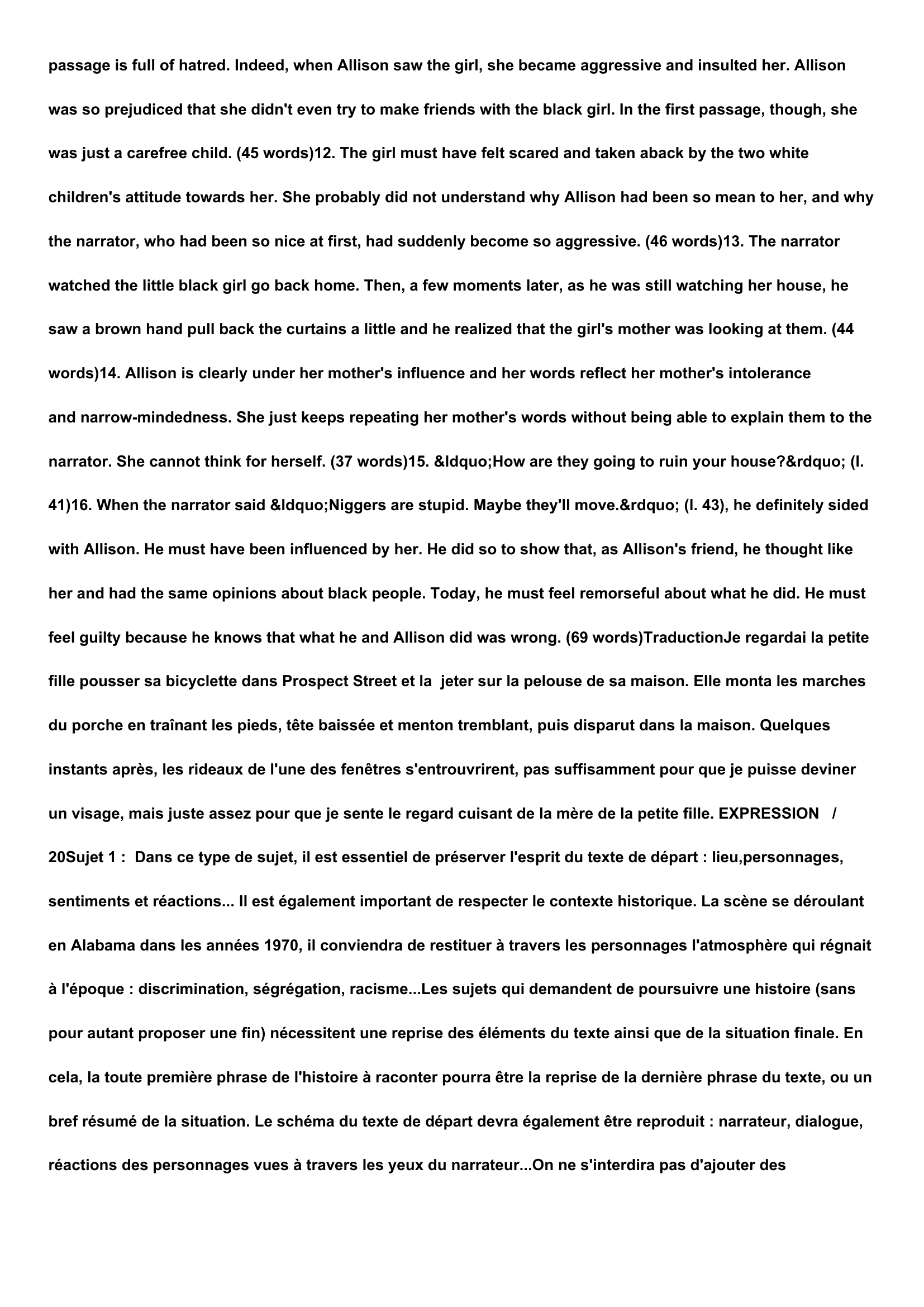The New Girl
Publié le 09/12/2012

Extrait du document
«
passage is full of hatred.
Indeed, when Allison saw the girl, she became aggressive and insulted her.
Allison
was so prejudiced that she didn't even try to make friends with the black girl.
In the first passage, though, she
was just a carefree child.
(45 words)12.
The girl must have felt scared and taken aback by the two white
children's attitude towards her. She probably did not understand why Allison had been so mean to her, and why
the narrator, who had been so nice at first, had suddenly become so aggressive.
(46 words)13.
The narrator
watched the little black girl go back home.
Then, a few moments later, as he was still watching her house, he
saw a brown hand pull back the curtains a little and he realized that the girl's mother was looking at them.
(44
words)14.
Allison is clearly under her mother's influence and her words reflect her mother's intolerance
and narrow-mindedness.
She just keeps repeating her mother's words without being able to explain them to the
narrator.
She cannot think for herself.
(37 words)15.
“How are they going to ruin your house?” (l.
41)16.
When the narrator said “Niggers are stupid.
Maybe they'll move.” (l.
43), he definitely sided
with Allison.
He must have been influenced by her.
He did so to show that, as Allison's friend, he thought like
her and had the same opinions about black people.
Today, he must feel remorseful about what he did.
He must
feel guilty because he knows that what he and Allison did was wrong.
(69 words)TraductionJe regardai la petite
fille pousser sa bicyclette dans Prospect Street et la jeter sur la pelouse de sa maison.
Elle monta les marches
du porche en traînant les pieds, tête baissée et menton tremblant, puis disparut dans la maison.
Quelques
instants après, les rideaux de l'une des fenêtres s'entrouvrirent, pas suffisamment pour que je puisse deviner
un visage, mais juste assez pour que je sente le regard cuisant de la mère de la petite fille. EXPRESSION /
20Sujet 1 : Dans ce type de sujet, il est essentiel de préserver l'esprit du texte de départ : lieu,personnages,
sentiments et réactions...
Il est également important de respecter le contexte historique. La scène se déroulant
en Alabama dans les années 1970, il conviendra de restituer à travers les personnages l'atmosphère qui régnait
à l'époque : discrimination, ségrégation, racisme...Les sujets qui demandent de poursuivre une histoire (sans
pour autant proposer une fin) nécessitent une reprise des éléments du texte ainsi que de la situation finale.
En
cela, la toute première phrase de l'histoire à raconter pourra être la reprise de la dernière phrase du texte, ou un
bref résumé de la situation.
Le schéma du texte de départ devra également être reproduit : narrateur, dialogue,
réactions des personnages vues à travers les yeux du narrateur...On ne s'interdira pas d'ajouter des.
»
↓↓↓ APERÇU DU DOCUMENT ↓↓↓
Liens utiles
- THE NEW GIRL
- Fiche de lecture sur le chapitre 11: The Greek of the New Testament, par Mark Janse, sur la section IV de l’ouvrage, intitulé: Ancient Greek: structure and change, pages 646-653.
- What are the consequences of the discoveries of new plants by Europeans ?
- FILLE PERDUE (La) [The Lost Girl]. David Herbert Lawrence (résumé)
- The Girl from Ipanema - analyse de l'oeuvre.
























